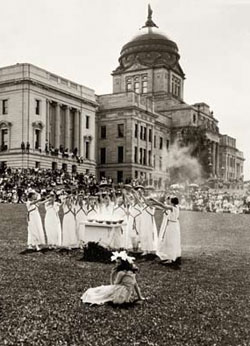Montana: Stories of the Land
Companion Website and Online Teacher's Guide
Chapter 10 - Politics and the Copper Kings, 1889-1904
Chapter 1 - Montana: Where the Land Writes History
Chapter 2 - People of the Dog Days
Chapter 3 - From Dog Days to Horse Warriors
Chapter 4 - Newcomers Explore the Region
Chapter 5 - Beaver, Bison, and Black Robes
Chapter 6 - Montana's Gold and Silver Boom
Chapter 7 - Two Worlds Collide
Chapter 8 - Livestock and the Open Range
Chapter 9 - Railroads Link Montana to the Nation
Chapter 10 - Politics and the Copper Kings
Chapter 11 - The Early Reservation Years
Chapter 12 - Logging in the "High Lonesome"
Chapter 13 - Homesteading This Dry Land
Chapter 14 - Towns Have Lives, Too
Chapter 15 - Progressive Montana
Chapter 16 - Montana and World War I
Chapter 17 - Montanans on the Move
Chapter 18 - The Great Depression Transforms Montana
Chapter 19 - World War II in Montana
Chapter 20 - Building a New Montana
Chapter 21 - A People's Constitution
Chapter 22 - Living in a New Montana
Learning From Historical Documents
Letter from Andrew Hammond to Samuel Hauser regarding the Capital Fight, November 1, 1894. Samuel Thomas Hauser papers, 1864-1914. Manuscript Collection 37. [box 10 folder 6]. Montana Historical Society Research Center. Archives. Excerpted in Not In Precious Metals Alone: A Manuscript History of Montana (Helena, 1976): 142-43.
Context for A. B. Hammond's Letter:
The fight over where to situate Montana's permanent capitol was one of the ugliest and most corrupt in Montana's history. By 1894 the principal contenders had been reduced to two: Helena and Anaconda. Deep in the matrix of the contest was economic as well as political rivalry. William Andrews Clark was a financial power in Montana-a mining millionaire - and so was Marcus Daly, head of the Anaconda Copper Company. Their economic rivalry and affluence spilled beyond the confines of their corporate interests and permeated all Montana politics. Naturally, Daly's sympathies and finances favored Anaconda as capital. Likewise, Clark rose to the challenge. No businessman or politician was exempt from the ramifications of the feud; no expense or county spared in the struggle. Missoula entrepreneur and lumber magnate A. B. Hammond discussed the campaign's status in western Montana, illustrating how local issues, like county seat fights, became means to statewide political ends.
About Primary Sources:
Letters, diary entries, census records, newspapers, and photographs are all examples of "primary sources," material created at a particular moment in the past that has survived into the present. Primary sources can provide clues to the past. They are our windows into an earlier time. The Montana Historical Society contains thousands of primary sources. In the 1970s, archivists collected just a few snippets into a book, which they called Not in Precious Metals Alone: A Manuscript History of Montana. That book is now on the web in its entirety. The above sample from that book relates directly to this chapter.

